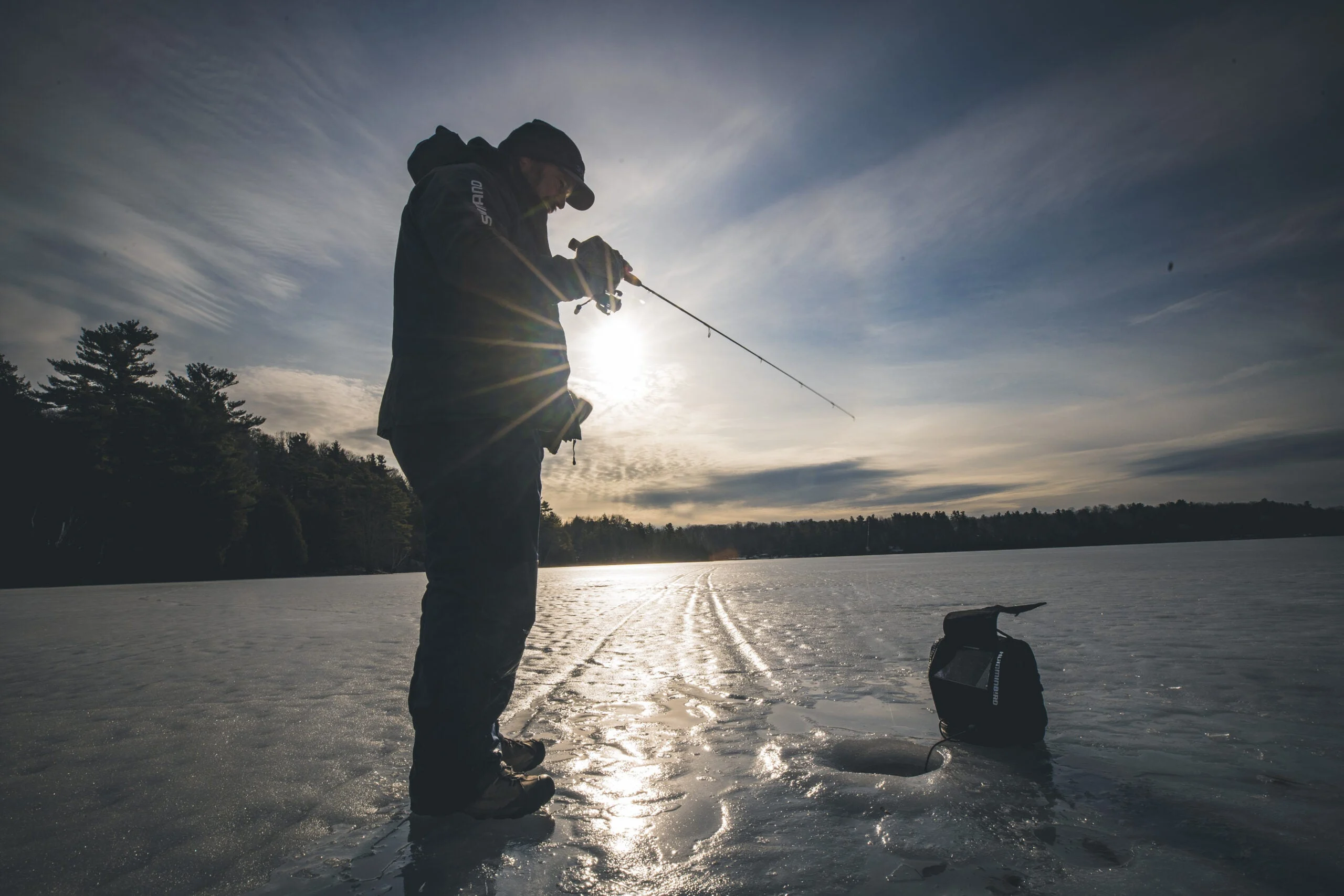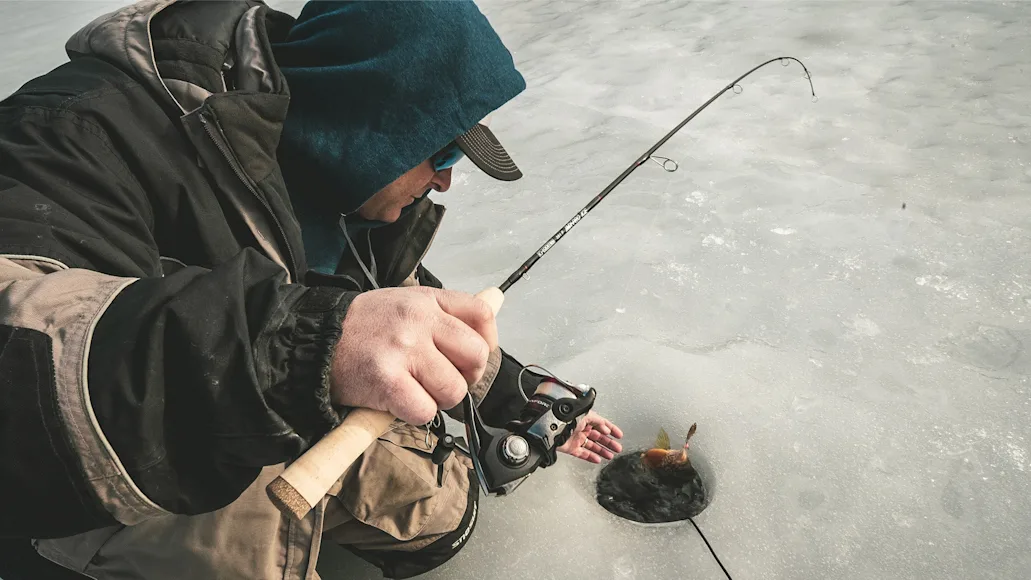Ice fishing is a winter pastime throughout many northern communities. Once lakes, ponds, and backwaters freeze solid, anglers drill holes through the ice and present a mixture of live and artificial bait options below for a variety of gamefish. In areas with consistent winters and quality waterbodies, ice fishing is a popular winter activity and an important part of the local economy.
Not only is it a great cure for cabin fever, but ice fishing can also produce some of the best fishing of the season, with hot action and potential for trophy catches. For anglers without access to a boat, the winter months can be the only chance to explore water past a cast’s length from shore. Plus, the hardware allows anglers to pursue a variety of fish species.
Before venturing out onto the ice, it is essential to learn the basics of ice safety. From there, an angler needs to dial in on the species present in their home waters, obtain a few pieces of gear, and learn the tactics necessary to catch fish through the ice. This beginner’s guide will walk you through the ice fishing basics and everything you need to have success on hard water.

Ice Safety
Understanding ice safety is the most important part of ice fishing. Anglers should always check the ice before venturing out onto the water. Ice can never be considered 100 percent safe, and it is smart to be overly cautious. If ice ever seems questionable, don’t go onto it.
I follow a few rules to ensure I can fish safely. These guidelines are especially important during the first and last ice periods of the season, as conditions can change dramatically in a very short amount of time. For more info on ice safety, visit your state’s Fish and Game Department website or connect with local officials. But always remember the following four rules:
Four inches of solid black ice is safe to walk on. Stay off anything less.
Practice the buddy system. Never go alone.
Always have a throw rope and emergency ice picks handy.
Check the ice with a spud bar on your way out and in the area where you plan to fish.
Species to Target
While most game fish can be successfully targeted through the ice, a few stand alone. For many, an outing is normally focused on either panfish (yellow perch, bluegills, and crappie), likely in hopes of enough fillets for a fish fry, or trophy predatory species like pike, lake trout, and walleye. Here is a closer look at the two subgroups of fish.
Panfish
The term panfish is a general way of describing smaller freshwater species that provide exceptional table fare that can easily fit into a pan. Part of the appeal of panfish is that they are present in just about any body of water. With a bit of know-how, keeper-size fish can be caught relatively easily. By and large, most ice fishing anglers target panfish with jigging tactics as they allow for a more mobile approach.
The bluegill is one of the most targeted species through the ice due to its abundance, scrappy fight on ultra-light tackle, and excellent table fare. While bluegill migrate throughout the season, weedy flats and defined edges are always good places to look. Crappie are another popular panfish species that roam around similar areas. Otherwise known as ”papermouths,” crappie can grow to impressive size and have a reputation for being light biters. They are also great eaters.
But no species is as popular among ice fishers as the yellow perch throughout the Great Lakes region. Large schools of perch often congregate on expansive mud flats, where they feed on blood worms and small baitfish throughout the winter. Limits are usually high, and these fish taste great after a bath in the fryer.

Predators
Ice anglers looking for a bigger trophy often target northern pike, lake trout, and walleye. These fish terrorize native forage and tempt anglers with the prospect of growing to impressive sizes. While these species can certainly all be caught jigging, anglers commonly target them with large live baits fished via tip-ups.
Out of these three species, the northern pike is king. Because of their large size and hard-fighting nature, pike are among the most exciting fish to target through the ice. While most pike are caught in shallow, weedy areas, larger fish are common in deeper water. In clear lakes with pelagic baitfish such as smelt and ciscoes, lake trout can be found in big numbers. As far as tactics, lakers are fished similarly to pike. And no list of popular ice fishing species would be complete without mention of the walleye. Their popularity can likely be traced back to widespread distribution and the endless methods used to target them. Walleye also are very active after dark, giving serious anglers plenty of opportunity to chase them.
Ice Fishing Tactics
Broadly speaking, ice fishing can be split into two distinct tactics—setting lines, otherwise known as tip-ups and jigging. Here is a brief overview of each method.
Jigging
When it comes to picking off active fish, jigging is tough to beat. The basics are simple: an angler vertically presents a wide variety of artificial offerings and jigs the bait in various cadences to elicit a strike. Consider fishing multiple sizes and colors of the Rapala jigging rap for larger predators, Acme Tackle tungsten ice jigs for panfish, and the Swedish Pimple for just about anything that swims. Many jigging fanatics also use some sort of ice fishing sonar, such as the Vexilar FL-8SE. These units help anglers quickly find and stay on active fish.
Tip-Ups
While jigging forces an angler to focus on one hole at a time, tip-ups provide a set-it-and-forget-it style alternative. Once an attractive piece of structure is identified, tip-ups let anglers set multiple lines with live bait at a desired depth to cover large sections of water. It is no secret that big fish gravitate to big forage; for this reason, many trophy fish fall victim to tip-up presentations. Learn more about this style of fishing in our tip-up fishing guide.
Equipment
As with anything else, ice fishing gear ranges from basic to specialized. It is important to prioritize a few pieces of high-quality cold-weather gear, an auger, and just enough fishing tackle to experience a few different tactics. Before purchasing any gear, be sure to visit your local tackle shop at the tail end of the ice fishing season. Stores will often run end-of-season sales to make room for spring gear. Here are some of the core items you will need:
Ice Fishing Boots
Nothing ruins a day on the ice faster than wet feet. It is important to invest in a good pair of boots that will provide seasons of comfort and durability. My longstanding favorite is Cabela’s Inferno Insulated Waterproof Hunting Boot. Although they are not marketed directly for ice fishing, these boots are extremely comfortable and warm enough for any conditions.
Ice Fishing Suit
While warm feet are important, keeping a toasty core temperature also needs to be top of mind. The Norfin Element Float Suit is a great pick that promises comfort even during brutal cold snaps. In the last few decades, many bib and jacket combos have come into play with technology that provides buoyancy in the event of a breakthrough. Consider purchasing a suit with these options.
Ice Auger
Over the last decade, ultralight electric augers have taken the ice fishing world by storm. Many anglers are even favoring auger systems that are compatible with cordless drills. However, for beginners, I would suggest looking at a high-quality hand auger such as the Eskimo 7”.
Jigging Rod
As an ice angler begins to favor specific species and tactics, the gear becomes more specialized. During the early stages, gear that applies to any scenario should be considered. For this application, the Ugly Stik GX2 is a well-rounded option that can withstand the use and abuse of long days on the ice.
Tip-Ups
Setting lines draws many people to ice fishing. Part of the appeal is that tip-ups are simple to operate and require limited attention. A great entry-level choice is the Bass Pro Shops Ice Classic Tip-Up, which is affordable and offers all the features of higher-valued options.
Jet Sled
Once all the gear is acquired, now you need a way to transport it. The Shappell Jet Sled is as classic as it gets and is crafted to easily slide on ice or deep snow. Additionally, the dimensions are designed to conveniently slip into the bed of a truck or trunk of an SUV.
FAQs
Q: Where is the best ice fishing in the country?
The Upper Midwest has the best ice fishing opportunities based on the number of species present, available water, and consistent winters. However, if you do not live in the region, no need to worry; other northern states have tremendous options.
Eastern states like Maine, New York, New Jersey, Pennsylvania, Ohio, and even Maryland have great hard water scenes during the right winter. Heading West, California, Colorado, Nevada, and Arizona all have the elevations necessary to produce safe ice.
Q: Are there special regulations during the ice fishing season?
Individual states often have separate regulations during the winter to protect vulnerable species from overharvesting or limit the number of lines you may deploy. As all states vary, be sure to refer to your state’s Fish and Game Department.
Q: Are fish safe to eat during the winter?
Unless otherwise noted due to polluted waterways, yes, fish are safe to eat in the wintertime. Some folks prefer harvesting fish through the ice as the cold water creates firmer fillets and fresher flavors.
Final Thoughts on Ice Fishing
Always check for solid, safe ice before venturing out on the water. Then, use the tactics and gear mentioned above to pursue one or all of the most popular hard water species. No matter what you choose and how you do it, ice fishing is a great way to burn off cabin fever and land some fish.

